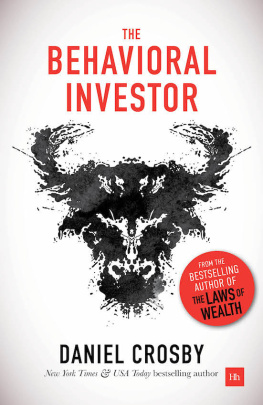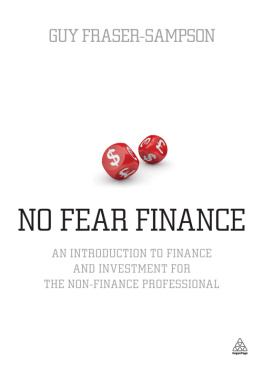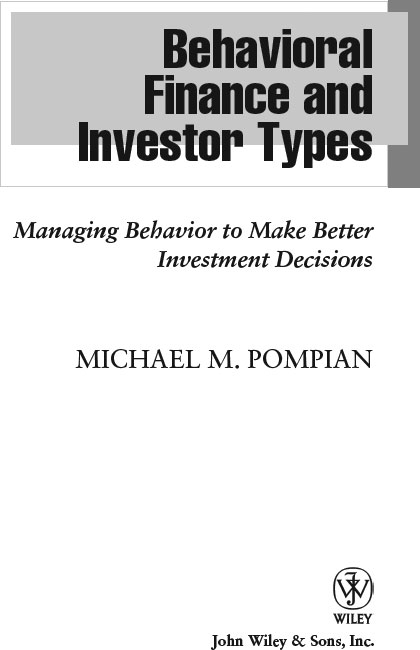Founded in 1807, John Wiley & Sons is the oldest independent publishing company in the United States. With offices in North America, Europe, Australia and Asia, Wiley is globally committed to developing and marketing print and electronic products and services for our customers professional and personal knowledge and understanding.
The Wiley Finance series contains books written specifically for finance and investment professionals as well as sophisticated individual investors and their financial advisors. Book topics range from portfolio management to e-commerce, risk management, financial engineering, valuation and financial instrument analysis, as well as much more.
For a list of available titles, visit our Web site at www.WileyFinance.com .
Copyright 2012 by Michael M. Pompian. All rights reserved.
Published by John Wiley & Sons, Inc., Hoboken, New Jersey.
Published simultaneously in Canada.
No part of this publication may be reproduced, stored in a retrieval system, or transmitted in any form or by any means, electronic, mechanical, photocopying, recording, scanning, or otherwise, except as permitted under Section 107 or 108 of the 1976 United States Copyright Act, without either the prior written permission of the Publisher, or authorization through payment of the appropriate per-copy fee to the Copyright Clearance Center, Inc., 222 Rosewood Drive, Danvers, MA 01923, (978) 750-8400, fax (978) 646-8600, or on the Web at www.copyright.com . Requests to the Publisher for permission should be addressed to the Permissions Department, John Wiley & Sons, Inc., 111 River Street, Hoboken, NJ 07030, (201) 748-6011, fax (201) 748-6008, or online at http://www.wiley.com/go/permissions .
Limit of Liability/Disclaimer of Warranty: While the publisher and author have used their best efforts in preparing this book, they make no representations or warranties with respect to the accuracy or completeness of the contents of this book and specifically disclaim any implied warranties of merchantability or fitness for a particular purpose. No warranty may be created or extended by sales representatives or written sales materials. The advice and strategies contained herein may not be suitable for your situation. You should consult with a professional where appropriate. Neither the publisher nor author shall be liable for any loss of profit or any other commercial damages, including but not limited to special, incidental, consequential, or other damages.
For general information on our other products and services or for technical support, please contact our Customer Care Department within the United States at (800) 762-2974, outside the United States at (317) 572-3993 or fax (317) 572-4002.
Wiley also publishes its books in a variety of electronic formats. Some content that appears in print may not be available in electronic books. For more information about Wiley products, visit our web site at www.wiley.com .
Library of Congress Cataloging-in-Publication Data:
Pompian, Michael M., 1963
Behavioral finance and investor types : managing behavior to make better investment decisions / Michael M. Pompian.
p. cm.(Wiley finance series)
Includes index.
ISBN 978-1-118-01150-8 (cloth); ISBN 978-1-118-22181-5 (ebk);
ISBN 978-1-118-23560-7 (ebk); ISBN 978-1-118-26048-7 (ebk)
1. InvestmentsPsychological aspects. 2. InvestmentsDecision making. I. Title.
HG4515.15.P657 2012
332.6019dc23
2011052854
This book is dedicated to my brother Dave and his family, Hali, Tyler, and Sascha.
Foreword
Fishermen often use the expression to set the hook and that is what I hope to do for Behavioral Finance and Investor Types . Michael Pompian graciously asked me if I would write this Foreword and, in a blink, I agreed. Why? Because the investing pond is full of investors who need to take the hook Michael is presenting here.
You are about to read and solve a mystery of sorts. It lifts the curtain on what lurks behind investment choicesimproperly formulated choices that so often derail expectations. This book takes the often tedious and proverbial scraping and sanding before painting and makes it the intriguing cornerstone of investing. Ben Franklin, always insightful about visionaries, wrote in the 1769 Farmers' Almanac , There are three things extremely hard: steel, a diamond, and to know one's self. To make sound choices, you must know yourself in order to know what decisions your personality can withstand when building and implementing an investment policy and process. You must know yourself, or the organization for which you serve, well enough to convey the beliefs, preferences, and biases about those whom you have chosen to advise you on investment decisions. This includes brokers, consultants, investment advisors, and so on. To be unable to do so is a prescription for inappropriate asset selection and portfolio compositiona far too common outcome. This is true from both an expected return and an expected risk perspective.
It is hard to imagine how much effort and knowledge was required to create this book. To focus effectively on what drives different types of personalities and match those personalities with an appropriate, fitted investing solution requires a long and patient observer and practitioner, like Michael Pompian. After many years in the consulting business, Michael has honed a deep psychological understanding of investor personalities, and accurately characterizes and classifies them into types. He is a rare breed with his deep knowledge of what drives investors and what drives portfoliosan elementary alignment that is the missing ingredient for the vast majority of investorsboth individuals and institutions.
Behavioral Finance is about the psychology that drives financial or investment choices in an uncertain future environment. Behavioral finance has been mostly under the wing of the academic community whose research has become prolific enough to offer a source of meaning and direction for investors. Twenty years ago behavioral finance was mostly a nebulous, certainly unrequited, and scattered collection of research by those who dared to tamper with classical views of finance. Recognizing the overwhelming role of psychology in decision making has forever changed the role of individuals and groups in making investment choices! Way back in the 1930s, John Maynard Keynes wrote of animal spirits, a now bantered catch-all for our behavior as investors. Then, in 2002, Daniel Kahneman put behavioral finance front and center by winning the Nobel Prize in Economics. Kahneman is a psychologist and points out that he has never taken a course in economics. Since that event, interest in behavioral finance has catapulted to become a source of rationale for investors' decisions.
Michael has done yeoman's service in taking years of academic research and his own practitioner insights to illuminate the mandatory need to understand the virtues of the physiological implications of choice. He is bringing these essential findings to the forefront of untangling everyday investment thinking with the clear mandate of implementing sound investment decisions. His combined knowledge of the inherent drivers of investor behavior, and years of careful observation, clearly illuminates that shoe sizes, so to speak, vary a great deal. He has effectively typed investorsbe they individuals or institutionsas a way to narrow and clarify what choices would be best for them. This sanding and scraping provides compatibility between investor expectations and ultimate results.





![Tim Richards [Tim Richards] - Investing Psychology: The Effects of Behavioral Finance on Investment Choice and Bias, + Website](/uploads/posts/book/124122/thumbs/tim-richards-tim-richards-investing-psychology.jpg)
![Daniel Crosby [Daniel Crosby] - The Laws of Wealth: Psychology and the secret to investing success](/uploads/posts/book/124058/thumbs/daniel-crosby-daniel-crosby-the-laws-of-wealth.jpg)

